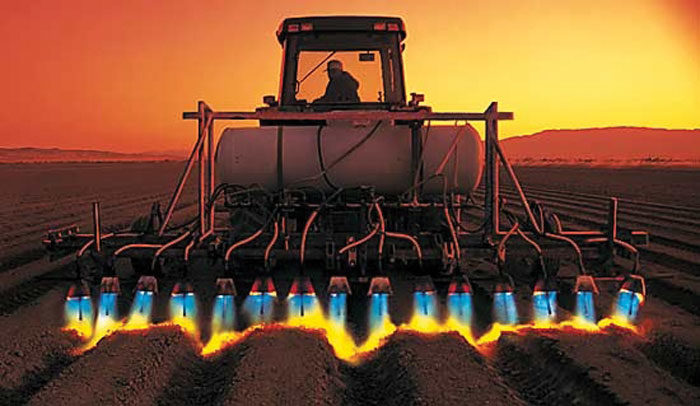Cover croppers seeking to improve the effectiveness of using a roller-crimper to terminate standing covers ahead of the planter may want to consider adding flames to the procedure.
Recent Italian studies using three different roller-crimper designs and a separate propane-fueled flaming operation showed significant improvements in plant deactivation and more predictable and timely dry-down of rolled standing covers.
Using propane burners for agronomic weed control has previously been shown an effective method in various row crops in the U.S. For example, a popular 2010 study credited the practice with a 95% control rate on Larry Stanislav’s 300-acre organic corn, soybean and wheat rotation near Abie, Neb.
That research led to the development of a training manual for the practice in corn and soybeans and the commercialization of a 4-row banded/full propane weed control system marketed by Agricultural Flaming Innovations.
The flames do not harm soil micro-organisms nor do they involve tillage. Both subjects are increasingly important to growers seeking to improve soil health. Flaming can also be used in a timely manner regardless of wet soils or when wind might make herbicide applications unfeasible.
The practice has become an approved weed control method for organic farms.
Plant physiologists say exposing weeds, or green material, to flame temperatures above 1,299 degrees F devitalizes proteins within the plant causing a more rapid wilt and desiccation, although it does not destroy plant tissues.
Increasingly stringent European Union controls on herbicides, particularly glyphosate, spawned the 2016-17 Italian studies. University of Perugia researchers published results in 2019.
The 2-year project used 24 randomized replicated plots of standing barley and field peas sown in October after wheat harvest and terminated in April. Three rollers of different designs were used; including an out-of-production heavy 1940s-vintage Fleco roller, a German-designed Clemens Eco-roll mounted on a hexagonal frame and using a pair of cylindrical water-weighted drums, and a custom-built roller crimper designed by the Rodale Institute.
The University of Pisa designed the flaming machine, which featured four 20-inch wide propane burners adjusted for a 1,300 F flame and arranged for a 6-foot working width. A light-duty tractor pulled the machine through the plots at 1 mph.
The tests were conducted with a separate rolling/crimping pass, immediately followed by a flame application. The 2-pass operation is more expensive than a single pass by a roller/crimper/flaming implement, but researchers say no such implement is currently commercially available. Their project was aimed specifically at the effectiveness of adding flame to the roller/crimper termination process.
Cover crop density before and after the tests was measured by digital imaging corrected for ambient light.
Compared with rolling and crimping alone, the study showed flaming in addition to rolling reduced green matter nearly two-fold with each of the implements within 24 hours of the procedure. Researchers observed differences in effectiveness of the machines the termination, but the improvements netted by adding flames were statistically significant across the project.
In both years 50% of the green cover was devitalized within 1 week in the flame treatments, while rolling/crimping alone took 2 weeks to achieve the same results.
Studies show the economic threshold for cover crop control requires about 85% suppression, based on industry standards for chemical herbicides. The Italian researchers reported they achieved that rate only with the flame treatments in conjunction with rolling and crimping.
Researchers also concluded the process significantly shortened the time needed to achieve cover crop desiccation over using rollers alone. The paper also notes improved termination allows for additional flexibility and a bigger “planting window” for establishing crops in the terminated plant material.
Researchers say the high cost of adding a time-consuming flaming procedure to mechanical termination probably will hamper widespread adoption of the process for no-till and cover crops.
However, in areas where herbicide use faces increasing regulation, or on operations wanting to reduce herbicide use, they say there could be an incentive for growers and equipment manufacturers to combine roller/crimpers with flaming equipment to provide the results in a single pass.







